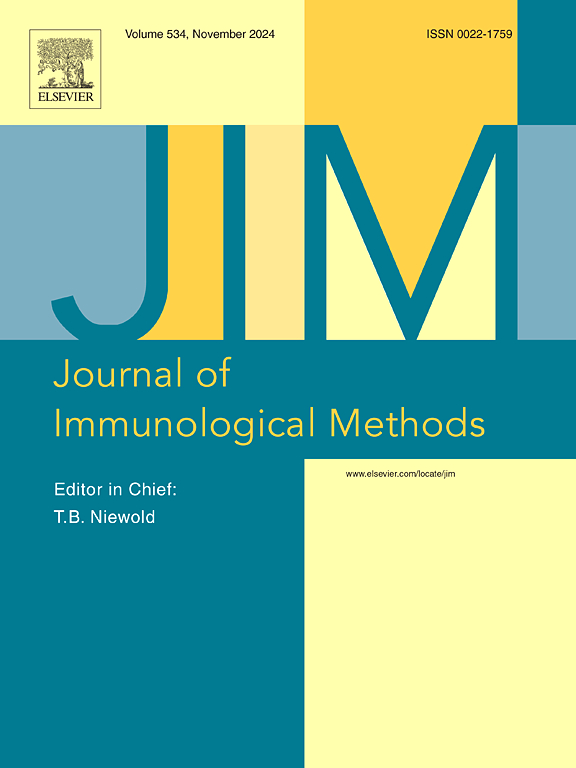Chimeric protein A/G conjugate based lateral flow assay for the rapid detection of brucellosis in multiple animal species
IF 1.6
4区 医学
Q4 BIOCHEMICAL RESEARCH METHODS
引用次数: 0
Abstract
The study highlights diagnostic efficacy of chimeric protein A/G based lateral flow assay (LFA) for on-spot diagnosis of brucellosis in various livestock species. The test device was developed using chimeric protein A/G conjugated with 40 nm colloidal gold nanoparticles as detection reagent having a strong binding affinity specifically IgG isotypes in multiple livestock species. Known positive and negative control sera samples from three livestock species and 36 Gram-negative bacterial cross-reactive hyper immune sera were used for determining the analytical sensitivity (ASn) and specificity (ASp), respectively. The diagnostic performance of LFA was evaluated in comparison with RBPT (Rose Bengal Plate Test) and indirect enzyme linked immunosorbent assay (iELISA) using 652 small ruminants, 532 bovine and 241 pig samples. The analytical sensitivity of LFA was observed up to 1:1280, 1:2560, and 1:10240 dilutions in bovine, small ruminants and pigs samples, respectively. Similarly, non-reactive to 35 Gram-negative bacterial cross-reactive hyper immune sera showed high ASp for LFA test except mild reactivity with Y. enterocolitca O9. Considering RBPT as gold standard, the diagnostic sensitivity (DSn) of protein A/G based LFA in infected farm samples was 93.9 (86.3–97.9) in small ruminants, 84.6 (54.5–98.1) in cattle and 96.5 (82.2–99.9) in swine. Considering iELISA as gold standard, the DSn of LFA was 96.3 (89.4–99.2) in small ruminants, 90 (55.5–99.7) in cattle and 96.7 (82.8–99.9) in swine. The higher performance efficacy of the LFA tests developed in this study outlines the practicality of using these rapid, easy to perform, highly sensitive and specific devices for on-spot screening of brucellosis in livestock species, which in-turn facilitate prevention, control and management of disease transmission in farms.
基于 Himeric 蛋白 A/G 结合物的横向流动分析法,用于快速检测多种动物的布鲁氏菌病。
本研究强调了基于嵌合蛋白A/G的横向流动试验(LFA)对多种家畜布鲁氏菌病现场诊断的有效性。该检测装置以嵌合蛋白A/G与40 nm胶体金纳米粒子偶联为检测试剂,对多种家畜具有很强的特异性IgG同型结合亲和力。采用3种家畜已知阳性和阴性对照血清和36份革兰氏阴性细菌交叉反应超免疫血清,分别测定分析灵敏度(ASn)和特异性(ASp)。采用652只小反刍动物、532头牛和241头猪,与RBPT(玫瑰孟加拉平板试验)和间接酶联免疫吸附试验(iELISA)进行比较,评价LFA的诊断性能。LFA在牛、小反刍动物和猪样品中的分析灵敏度分别达到1:1280、1:2560和1:10240的稀释度。同样,对35革兰氏阴性细菌交叉反应性超免疫血清无反应,除对小肠结肠炎Y. O9有轻微反应外,对LFA试验显示高ASp。以RBPT为金标准,小反刍动物、牛和猪的LFA诊断灵敏度分别为93.9(86.3-97.9)、84.6(54.5-98.1)和96.5(82.2-99.9)。以iELISA为金标准,小反刍动物LFA的DSn为96.3(89.4 ~ 99.2),牛为90(55.5 ~ 99.7),猪为96.7(82.8 ~ 99.9)。本研究开发的LFA测试具有较高的性能效果,说明使用这些快速、易于执行、高灵敏度和特异性的设备现场筛查牲畜品种中的布鲁氏菌病的实用性,从而促进了农场疾病传播的预防、控制和管理。
本文章由计算机程序翻译,如有差异,请以英文原文为准。
求助全文
约1分钟内获得全文
求助全文
来源期刊
CiteScore
4.10
自引率
0.00%
发文量
120
审稿时长
3 months
期刊介绍:
The Journal of Immunological Methods is devoted to covering techniques for: (1) Quantitating and detecting antibodies and/or antigens. (2) Purifying immunoglobulins, lymphokines and other molecules of the immune system. (3) Isolating antigens and other substances important in immunological processes. (4) Labelling antigens and antibodies. (5) Localizing antigens and/or antibodies in tissues and cells. (6) Detecting, and fractionating immunocompetent cells. (7) Assaying for cellular immunity. (8) Documenting cell-cell interactions. (9) Initiating immunity and unresponsiveness. (10) Transplanting tissues. (11) Studying items closely related to immunity such as complement, reticuloendothelial system and others. (12) Molecular techniques for studying immune cells and their receptors. (13) Imaging of the immune system. (14) Methods for production or their fragments in eukaryotic and prokaryotic cells.
In addition the journal will publish articles on novel methods for analysing the organization, structure and expression of genes for immunologically important molecules such as immunoglobulins, T cell receptors and accessory molecules involved in antigen recognition, processing and presentation. Submitted full length manuscripts should describe new methods of broad applicability to immunology and not simply the application of an established method to a particular substance - although papers describing such applications may be considered for publication as a short Technical Note. Review articles will also be published by the Journal of Immunological Methods. In general these manuscripts are by solicitation however anyone interested in submitting a review can contact the Reviews Editor and provide an outline of the proposed review.

 求助内容:
求助内容: 应助结果提醒方式:
应助结果提醒方式:


